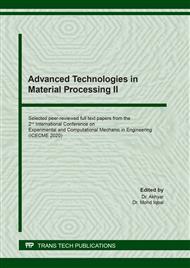[1]
A. Maaty, Fatigue and rutting lives in flexible pavement, Ain Shams Univ. 3 (2012) 367–374.
DOI: 10.1016/j.asej.2012.04.008
Google Scholar
[2]
T. Suprapto, Highway Materials and Structures, third ed., KMTS FT UGM, Yogyakarta. (2006).
Google Scholar
[3]
A. Hassani, M. Taghipoor, and M. M. Karimi, A state of the art of semi-flexible pavements : Introduction, design, and performance, Constr. Build. Mater. 253 (2020) 119196-119206.
DOI: 10.1016/j.conbuildmat.2020.119196
Google Scholar
[4]
S. M. Saleh, R. Anggraini, and H. Aquina, Characteristics of Porus Asphalt Mixture with Styrofoam Substitution on 60/70 Penetration Asphalt, J. Tek. Sipil. 21 (2014) 753-761.
DOI: 10.5614/jts.2014.21.3.7
Google Scholar
[5]
R. Ismy, S. M. Saleh, M. Isya, and Husaini, Deformation Velocity Analysis on Hot Asphalt Mixture Using Wire Mesh Layer as Reinforcement, Int. J. Psychosoc. Rehabil. 24 (2020) 502-509.
DOI: 10.4028/www.scientific.net/kem.892.99
Google Scholar
[6]
R. Ismy, The Effect of Compaction Temperature on the Stability of Asphalt Concrete Mixtures in Gradual Aggregates Using Cellulose Fibers, J. Variasi. 3 (2011) 81-88.
Google Scholar
[7]
Bukhari, Material Engineering and Pavement Thickness, Engineering Faculty, Universitas Syiah Kuala. (2007).
Google Scholar
[8]
Sukirman, S, Hot Mixed Asphalt Concrete, first ed, Granit, Jakarta. (2003).
Google Scholar
[9]
Suryawan. A, Portland Cement Concrete Pavement (Rigid Pavement), Beta Offset. Jakarta. (2005).
Google Scholar
[10]
N. S. Correia and J. G. Zornberg, Strain distribution along geogrid-reinforced asphalt overlays under traffic loading, Geotext. Geomembr. 46 (2018) 111–120.
DOI: 10.1016/j.geotexmem.2017.10.002
Google Scholar
[11]
A. M. Elleboudy, N. M. Saleh, and A. G. Salama, Assessment of geogrids in gravel roads under cyclic loading, Alex. Eng. J. 56 (2017) 319–326.
DOI: 10.1016/j.aej.2016.09.023
Google Scholar
[12]
R. Razuardi, S. M. Saleh, and M. Isya, The Effect of Additional Buton Rock Asphalt (BRA) as Filler in Wearing Layer (AC-WC) Laston Mixed, J. Tek. Sipil. 1 (2018) 715–724.
DOI: 10.24815/jts.v1i3.10031
Google Scholar
[13]
S. Widodo and I. Setyaningsih, Use of Marshall Tools to Test The Elasticity Modules of Asphalt Concrete, Simposium Nasional RAPI X FT UMS. (2011) 13-20.
Google Scholar
[14]
T. D. Iskandar, Z. A. Muis, and A. S. Lubis, Study Determining The Value of The AC-WC Types of Asset Concrete Modulus, Department of Civil Engineering, Universitas Sumatera Utara. (2016) 14-22.
Google Scholar
[15]
S. P, M. Warman, and I. Farni, Rigid Pavement Planning in Road of ' Padang city limits - haru intersection, Department of Civil Engineering, Universitas Sumatera Utara. (2017) 15-20.
Google Scholar
[16]
L. F. Walubita, T. P. Nyamuhokya, J. J. Komba, H. Ahmed Tanvir, M. I. Souliman, and B. Naik, Comparative assessment of the interlayer shear-bond strength of geogrid reinforcements in hot-mix asphalt, Constr. Build. Mater. 191 (2018) 726–735.
DOI: 10.1016/j.conbuildmat.2018.10.035
Google Scholar
[17]
A. M. Nugroho, A. Setyawan, and F. P. Pramesti, Fatique Analysis on Wearing Course Using Classical Fatique Method, Department of Civil Engineering, Universitas Sumatera Utara. (2016) 8-17.
Google Scholar
[18]
A. Shen, S. Lin, Y. Guo, T. He, and Z. Lyu, Relationship between flexural strength and pore structure of pavement concrete under fatigue loads and Freeze-thaw interaction in seasonal frozen regions, Constr. Build. Mater. 174 (2018) 684–692.
DOI: 10.1016/j.conbuildmat.2018.04.165
Google Scholar
[19]
M. N. S. Hadi and A. S. A. Al-Hedad, Flexural fatigue behaviour of geogrid reinforced concrete pavements, Constr. Build. Mater. 249 (2020) 118762-118772.
DOI: 10.1016/j.conbuildmat.2020.118762
Google Scholar
[20]
M. A. C. López, W. Fedrigo, T. R. Kleinert, M. F. Matuella, W. P. Núñez, and J. A. P. Ceratti, Flexural fatigue evaluation of cement-treated mixtures of reclaimed asphalt pavement and crushed aggregates, Constr. Build. Mater. 158 (2018) 320–325.
DOI: 10.1016/j.conbuildmat.2017.10.003
Google Scholar
[21]
M. Jallu, A. Arulrajah, S. Saride, and R. Evans, Flexural fatigue behavior of fly ash geopolymer stabilized-geogrid reinforced RAP bases, Constr. Build. Mater. 254 (2020) 119263-119270.
DOI: 10.1016/j.conbuildmat.2020.119263
Google Scholar
[22]
A. Arulrajah, S. Perera, Y. C. Wong, S. Horpibulsuk, and F. Maghool, Stiffness and flexural strength evaluation of cement stabilized PET blends with demolition wastes, Constr. Build. Mater. 239 (2020) 117819-117825.
DOI: 10.1016/j.conbuildmat.2019.117819
Google Scholar
[23]
F. Yuan, M. Chen, and J. Pan, Flexural strengthening of reinforced concrete beams with high-strength steel wire and engineered cementitious composites, Constr. Build. Mater. 254 (2020) 119284-119292.
DOI: 10.1016/j.conbuildmat.2020.119284
Google Scholar
[24]
SNI 03-1732-1989, The Procedure for Planning for Flexible Pavement Thickness for Roads Using the Analysis of the Component Method, National Standardization Department (in: Indonesia). (1989).
Google Scholar
[25]
AASTHO, Standard Specification for Transportation Materials and Methods of Sampling and Testing, fifteen ed., Washington, DC. (1990).
Google Scholar
[26]
Huang Y H, Pavement Analisys and Design, University of Ketucky. London. (1993).
Google Scholar
[27]
D. Wang, X. Liang, D. Li, H. Liang, and H. Yu, Study on Mechanics-Based Cracking Resistance of Semiflexible Pavement Materials, Adv. Mater. Sci. Eng. (2018) 1–10.
DOI: 10.1155/2018/8252347
Google Scholar
[28]
S. Wu, Q. Ye, and N. Li, Investigation of rheological and fatigue properties of asphalt mixtures containing polyester fibers, Constr. Build. Mater. 22 (2008) 2111–2115.
DOI: 10.1016/j.conbuildmat.2007.07.018
Google Scholar
[29]
Adfords. G, Adfords Glassgrid Asphalt Reinforcement, glasgrid.eu@saint-gobain.com, www.glasgrid.com/eu. (2017).
Google Scholar
[30]
Adfords. G, Aplication of Pavement Reinforcement System Adfords Glassgrid, glasgrid.eu@saint-gobain.com, www.glasgrid.com/eu. (2017).
Google Scholar
[31]
Ferguson. M, Reinforced Concrete Basics, forth ed, Erlangga, Jakarta. (1986).
Google Scholar
[32]
Huang Y H, Pavement Analisys and Design, Pearson Prentice Hall, second ed, New Jersey, USA. (2004).
Google Scholar
[33]
M.-J. Kim, S. Kim, D.-Y. Yoo, and H.-O. Shin, Enhancing mechanical properties of asphalt concrete using synthetic fibers, Constr. Build. Mater. 178 (2018) 233–243.
DOI: 10.1016/j.conbuildmat.2018.05.070
Google Scholar
[34]
Sesaria, D A, The Effect of Crumb Rubber Gradation on Asphalt Mixture Characteristics, USU's Institutional Repository, Universitas Sumatera Utara. (2018).
Google Scholar


